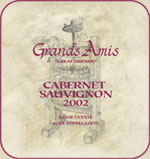 |
|
Wine Details
Price:
$22.00 per bottle
Description:
The 2002 Cabernet Sauvignon wine from the Eger vineyard is an exceptional wine. The color is dark garnet red with moderate depth. The aroma is very complex, yet youthful reminiscent of a nouveau style. It focuses on classical cabernet black cherry and raspberry fruit, with a tinge of minty chocolate and black licorice. The oak barrels used in aging impart a sweet vanilla character with nuances of campfire smokiness and dried thyme. The flavors mirror the aromas, and the texture is rich with full tannins. The finish is soft and lingering.
The vineyard selected for this cabernet wine is unique. Nestled by eucalyptus trees, it consistently produces wine with distinctive minty chocolate characters. The vines are naturally low yielding and are only lightly irrigated to intensify the flavors.
The wine consists of 95% cabernet sauvignon grapes, all from the Eger vineyard. Four percent petite sirah from the Elk vineyard was added to enhance the tannin profile. Small amounts of zinfandel, carignane, and sirah were blended to add fruit subtlety to the wine. The wine was aged for 16 months in both new American Francois Frerers tight grained oak (40%) and 2 year old French Latour Beaun oak (60%).
|
|
|